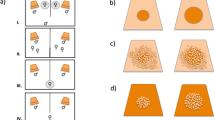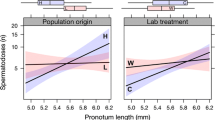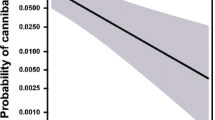Summary
Following bouts of courtship and copulation, female giant waterbugs (Belostoma flumineum Say) deposit eggs on the backs of their mates. Throughout a 6– to 12-day brooding period, males display several behaviors that are vital to egg-nymph survival. Consequently, females depend on male post-copulatory behaviors for successful reproduction and the possibility exists for male backspace availability to limit female reproduction in this species. I studied seasonal trends and factors that affect male backspace availability in populations of B. flumineum in east-central Illinois (USA). Early in the spring/summer, giant waterbug populations are relatively small and a large majority (188/205=91.7%) of the males are egg-laden; males experimentally added to the population during this period quickly became encumbered. In contrast, later in the summer after young-of-the-year emerge as adults, the waterbug population density increases dramatically and fewer (670/1274\2= 52.6%) of the males are encumbered (egg-laden). Of the males that are egg-laden both early and late in the season, significantly more are completely encumbered (i.e., 100% of the dorsum egg covered) early in the spring. The adult sex ratio is generally not biased and the number of eggs/pad that completely covers a male approximates a full ovarian complement. Therefore, these factors probably do not cause male backspace to become limited. The primary factor that appears to limit male backspace availability is the ability of females to synthesize a second partial clutch in a short time, often within 1 to 4 days. Females are capable of ovipositing partial clutches on 12 males within 30 days, whereas male brooding period is temperature dependent and ranges from 6 to 13 days. Newly emerged males are capable of breeding significantly sooner than can newly emerged females, thereby creating ample oviposition substrate for the females in the population after young-of-the-year adults appear. The evolution of sex-role reversal is not well understood; however it should not evolve in waterbugs unless male backspace limits female reproduction. Such a situation appears to exist in B. flumineum early in the season but not later in the summer.
Similar content being viewed by others

References
Barash DP (1982) Sociobiology and behavior, 2nd edn. Elsevier, New York
Berglund A, Rosenqvist G, Svensson I (1986) Reversed sex roles and parental investment in zygotes of two pipefish (Syngnathidae) species. Mar Ecol Prog Ser 29:209–215
Berglund A, Rosenqvist G, Svensson I (1988) Multiple matings and paternal brood care in the pipefish Syngnathus typhle. Oikos 51:184–188
Burley N (1977) Parental investment, mate choice, and mate quality. Proc Natl Acad Sci USA 74:3476–3479
Colwell MA (1986) The first documented case of polyandry for Wilson's phalarope (Phalaropus tricolor). Auk 103:611–612
Colwell MA, Oring LW (1988) Sex ratios and intrasexual competition for mates in a sex-role reversed shorebird, Wilson's phalarope (Phalaropus tricolor). Behav Ecol Sociobiol 22:165–173
Cullen MJ (1969) The biology of giant water bugs (Hemiptera: Belostomatidae) in Trinidad. Proc R Ent Soc London [A] 44 (7–9):123–137
Fiedler K (1954) Vergleichende Verhaltensstudien an Seenadeln, Schlangennadeln und Seepferdchen. Z Tierpsychol 11:358–416
Graul WD, Derrickson SR, Mock DW (1977) The evolution of avian polyandry. Am Nat 111:812–816
Gwynne DT (1981) Sexual difference theory: mormon crickets show role reversal in mate choice. Science 213:779–780
Hatziolos ME, Caldwell RL (1983) Role reversal in courtship in the stomatopod Pseudosquill ciliata (Crustacea). Anim Behav 31:1077–1087
Hilden O, Vuolanta S (1972) Breeding biology of the red-necked phalarope Phalaropus lobatus in Finland. Ornis Fenn 49:57–85
Höhn O (1969) The phalarope. Sci Am 220:105–111
Jenni DA (1974) Evolution of polyandry in birds. Am Zool 14:129–144
Knowlton N (1982) Paternal care and sex role reversal. In: King's College Sociobiology Group (eds) Current problems in sociobiology. Cambridge University Press, Cambridge, pp 203–222
Lauck DR, Menke AS (1961) The higher classification of the Belostomatidae (Hemiptera). Ann Entomol Soc Am 54:644–657
Menke AS (1960) A taxonomic study of the genus Abedus Stal (Hemiptera, Belostomatidae). Univ Calif Publ Entomol 16: 393–440
Oring LW, Maxson SJ (1978) Instances of simultaneous polyandry by a spotted sandpiper Acitis macularia. Ibis 120:349–353
Petrie M (1983) Mate choice in role reversed species. In: Bateson P (ed) Mate choice. Cambridge University Press, Cambridge, pp 167–179
Pitelka FA, Holmes RT, MacLean SF (1974) Ecology and evolution of social organization in arctic sandpipers. Am Zool 14:185–204
Reynolds JD (1987) Mating system and nesting biology of the sex-role reversed red-necked phalarope: what constrains polyandry? Ibis 129:225–242
Ridley M (1978) Paternal care. Anim Behav 26:904–932
Ridpath MG (1972) The Tasmanian native hens, Tribonyx mortierii, I–III. CSIRO Wildl Res 17:1–118
Smith RL (1976a) Brooding behavior of a male water bug Belostoma flumineum (Hemiptera: Belostomatidae). J Kans Entomol Soc 49:333–343
Smith RL (1976b) Male brooding behavior of the water bug Abedus herberti (Hemiptera:Belostomatidae). Ann Entomol Soc Am 69:740–747
Smith RL (1979) Paternity assurance and altered roles in the mating behavior of a giant water bug Abedus herberti (Heteroptera: Belostomatidae). Anim Behav 27:716–725
Smith RL (1980) Evolution of exclusive post-copulatory paternal care in the insects. Fla Entomol 63:65–78
Strawn K (1958) Life history of a pigmy seahorse, Hippocampus zosterae Jordan and Gilbert, at Cedar Key, Florida. Copeia 1958:16–22
Takai T, Mizokami A (1959) On the reproduction, eggs, and larvae of the pipefish, Syngnathus schlegeli Kaup. J Shimonoseki Coll Fish 8:85–89
Thornhill R, Alcock J (1983) The evolution of insect mating systems. Harvard University Press, Cambridge
Torre Bueno JR de la (1906) Life histories of North American water bugs. I. Life history of Belostoma flumineum Say. Can Entomol 38:189–197
Trivers RL (1972) Parental investment and sexual selection. In: Campell B (ed) Sexual selection and the descent of man. Aldine Press, Chicago, pp 136–179
Venkatesan P (1983) Male brooding behavior of Diploynchus indicus Venk and Rao (Hemiptera:Belostomatidae). J Kans Entomol Soc 56:80–87
Voelker J (1968) Untersuchungen zur Ernährung, Fortpflanzungsbiologie und Entwicklung von Limnogeton fieberi Mayr (Belostomatidae, Hemiptera) als Beitrag zur Kenntnis von natürlichen Feinden tropischer Süsswasserschnecken. Entomol Mitt 3:1–24
Wells KD (1977) The social behaviour of anuran amphibians. Anim Behav 25:666–693
Wells KD (1978) Courtship and parental behavior in a panamanian poison-arrow frog (Dendrobates auratus). Herpetologica 34:148–155
Williams GC (1966) Adaptation and natural selection. Princeton University Press, Princeton
Williams GC (1975) Sex and evolution. Princeton University Press, Princeton
Wittenberger JF (1981) Animal social behavior. Duxburg, Boston
Author information
Authors and Affiliations
Rights and permissions
About this article
Cite this article
Kruse, K.C. Male backspace availability in the giant waterbug (Belostoma flumineum Say). Behav Ecol Sociobiol 26, 281–289 (1990). https://doi.org/10.1007/BF00178321
Received:
Accepted:
Issue Date:
DOI: https://doi.org/10.1007/BF00178321



